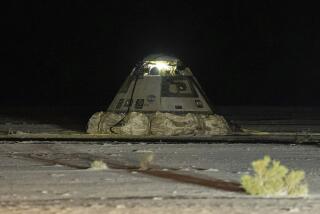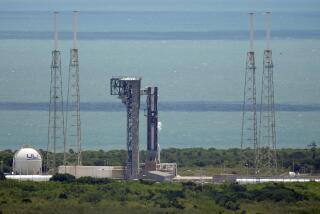COUNTDOWN TO DISASTER : Challenger’s Last Flight : 9. ALL READY : ‘What a Great Day for Flying’
A new day. Clear and cold. A pilot’s dream.
Another delay seemed out of the question. This would be the day.
Commander Dick Scobee beamed. “My kind of weather,” he told the ground crew. “What a great day for flying!”
At crew quarters, six miles from the launch pad, the wake-up call came at 6:18.
The seven gathered in the galley. At 6:48, they sat around a rectangular table, ate a light breakfast topped off with a white-frosted cake. Each astronaut’s name was written in icing and the cake was decorated with a drawing of the crew emblem and the orbiter Challenger.
When they posed for a photographer, everyone was smiling.
At 7:18, a 10-minute briefing capped six months of training. Then the seven shrugged on their powder-blue uniforms. At 7:48, they left for the launch pad.
Outside, the temperature was still freezing.
Engineers for NASA and the rocket booster manufacturers had discussed the cold in a phone call the night before. NASA was worried about the effect of the cold on rubber rings inside the rocket designed to protect against pressure leaks. The rocket maker, Morton Thiokol, recommended that they proceed with the launch, according to NASA.
The cold made it cozy in the “white room” when the astronauts entered at 8:13. Ground crew members crowded in to get out of the frigid morning air.
“We’re going to go today, aren’t we?” a happy Christa McAuliffe said after she stepped out of the gray NASA van and into the white room.
The astronauts were “very, very high,” said Johnny Corlew, 49, a quality assurance inspector for NASA. He had hoped to be on the “close-out crew” so he could give the teacher an apple before she left on the most important teaching assignment of her life.
Corlew’s wife bought the Red Rome apple for him at the supermarket.
“I grew up in Indiana and we had apple trees in our yard, so every once in a while I would take the teacher an apple,” he said. “I decided from the beginning that if I was on the close-out crew, I’d take her an apple.”
McAuliffe accepted Corlew’s gift, smiled and thanked him. “Save it for me and I’ll eat it when I get back,” she said.
“Sure will, Christa,” he responded.
Then Corlew and the other ground crew members helped the astronauts into their space vests and helmets, and they wiped the astronauts’ shoes, a regular procedure to prevent contamination of the inside of the orbiter.
At 8:23, the seven, wearing gloves because of the cold, crawled through the hatch into Challenger.
There was ice on the launch pad.
Corlew closed the hatch door behind the astronauts, making sure it was locked.
There were the routine pre-flight checks. Then the scheduled 9:38 liftoff was delayed two hours because of ice on the shuttle’s ground support structure. The temperature outside inched upward and the morning sun melted some of the ice.
At 11:38, the rumble of a launch began.
It was cold and clear. A pilot’s dream.
More to Read
Sign up for Essential California
The most important California stories and recommendations in your inbox every morning.
You may occasionally receive promotional content from the Los Angeles Times.










